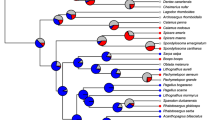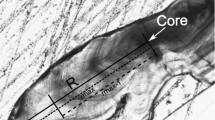Abstract
An alpheid shrimp,Athanas kominatoensis, inhabiting a Japanese purple sea urchin was shown to be a partially protandrous hermaphrodite. They settled mainly in summer and spent the first reproductive season as males. Smaller males changed into females the following spring, but larger ones remained males throughout their lives. Sex change was socially controlled, as has been known in some fishes. In contrast to the fishes, however, subordinates changed their sex as the best of a bad situation in this shrimp. Most larger individuals lived singly or in sexual pairs, not tolerating others of the same sex on a host. The larger a male was, the more likely he was to be found with a female. On the contrary, males smaller than 3 mm were tolerated by larger males to some extent and had chances to cohabit and copulate with larger females. This made it advantageous to be functional as a male at first. Though the secondary sex change from female to male is theoretically expected, it is hardly realized because of the short life span. Hermaphroditism in this shrimp can be explained by the size-advantage model as a special case.
Similar content being viewed by others
References
Aldenhoven, J.M. 1986 Different reproductive strategies in a sex-changing coral reef fishCentropyge bicolor (Pomacanthidae).Aust. J. Mar. Freshw. Res. 37: 353–360.
Bauer, R.T. 1986 Sex change and life history pattern in the shrimpThor manningi (Decapoda: Caridea): a novel case of partial protandric hermaphroditism.Biol. Bull. 170: 11–31.
Charnov, E.L. 1982. The theory of sex allocation. Princeton Univ. Press, Princeton. 355 pp.
Diesel, R. 1986 Optimal mate searching strategy in the symbiotic spider crabInachus phalangium (Decapoda).Ethology 72: 311–328.
Fricke, H. & S. Fricke 1977 Monogamy and sex change by aggressive dominance in coral reef fish.Nature. 266: 830–832.
Ghiselin, M. T. 1969 The evolution of hermaphroditism among animals.Q. Rev. Biol. 44: 189–208.
Gross, M.R. 1984 Sunfish, salmon, and the evolution of alternative reproductive strategies and tactics in fishes. In: G. W. Potts & R. J. Wootton (eds.)Fish reproduction: strategies and tactics. pp. 55–75. Academic Press, London.
Knowlton, N. 1980 Sexual selection and dimorphism in two demes of a symbiotic pair-bonding snapping shrimp.Evolution 34: 161–173.
Kuwamura, T. 1984 Social structure of the protogynous fishLabroides dimidiatus.Publ. Seto Mar. Biol. Lab. 29: 117–177.
Lassig, B. R. 1976 Field observation on the reproductive behavior ofParagobiodon spp. (Osteichthyes: Gobiidae) at Heron Island Great Barrier Reef.Mar. Behav. Physiol. 3: 283–293.
Lassig, B. R. 1977 Socioecological strategies adopted by obligate coral-dwelling fishes.Proc. 3rd Int. Symp. Coral Reefs 1: 565–570.
Moyer, J. T. 1987 Social organization and protogynous hermaphroditism in marine angelfishes (Pomacanthidae). In: A. Nakazono & T. Kuwamura (eds.)Sex change in fishes. pp. 120–147. Tokai Univ. Press, Tokyo. (In Japanese)
Moyer, J. T. & M. J. Zaiser 1984 Early sex change: a possible mating strategy ofCentropyge angelfishes (Pisces: Pomacanthidae).J. Ethol. 2: 63–67.
Nakazono, A. 1979 Studies on the sex reversal and spawning behavior of five species of Japanese labrid fishes.Rep. Fish. Res. Lab. Kyusyu Univ. 4: 1–64 (In Japanese with English summary).
Noël, P. 1973 Cycle biologique et inversion sexuelle du crustacé décapode NatantiaProcessa edulis.Cah. Biol. Mar. 14: 217–227.
Patton, W. K., R. J. Patton & A. Barnes 1985 On the biology ofGnathophylloides mineri, a shrimp inhabiting the sea urchinTripneustes ventricosus.J. Crust. Biol. 5 (4): 616–626.
Policasky, D. 1982 Sex change in plants and animals.Ann. Rev. Ecol. Syst. 13: 471–495.
Pomeranz, E. & M. Tsurnamal 1976 The symbiotic association between the shrimp,Athanas indicus, and the sea urchin,Echinometra mathaei, in the Gulf of Elat.Isr. J. Zool. 25: 204–205.
Ridley, M. 1983 The explanation of organic diversity: The comparative method and adaptations for mating. Clarendon Press, Oxford.
Robertson, D. R. 1972 Social control of sex reversal in a coral reef fish.Science 177: 1007–1009.
Ross, R. M., G. S. Losey & M. Diamond 1983 Sex change in a coral reef fish: Dependence of stimulation and inhibition on relative size.Science 221: 574–575.
Shapiro, D. Y. 1979 Social behavior, group structure and the control of sex reversal in hermaphroditic fish.Adv. Study Behav. 10: 43–102.
Suzuki, H. 1970 Taxonomic review of four alpheid shrimps belonging to the genusAthanas with reference to their sexual phenomena.Sci. Rep. Yokohama Natl. Univ., Sect. 2, 17: 1–37.
Warner, R. R. 1975 The adaptive significanse of sequential hermaphroditism in animals.Am. Nat. 109: 61–82.
Warner, R. R. 1984 Mating behavior and hermaphroditism in coral reef fishes.Am. Scient. 72: 128–136.
Warner, R. R. & S. G. Hoffman 1980 Local population size as a determinant of mating system and sexual composition in two tropical marine fishes (Thalassoma spp.)Evolution 34: 508–518.
Wirtz, P. & R. Diesel 1983 The social structure ofInachus phalangium, a spider crab associated with the sea anemoneAnemonia sulcata.Z. Tierpsychol. 62: 209–234.
Yanagisawa, Y. 1984 Studies on the interspecific relationship between gobiid fish and snapping shrimp. 2. Life history and pair formation of snapping shrimpAlpheus bellutus.Publ. Seto Mar. Biol. Lab. 29: 93–116.
Author information
Authors and Affiliations
About this article
Cite this article
Nakashima, Y. Reproductive strategies in a partially protandrous shrimp,Athanas kominatoensis (decapoda: alpheidae): Sex change as the best of a bad situation for subordinates. J. Ethol. 5, 145–159 (1987). https://doi.org/10.1007/BF02349947
Received:
Accepted:
Issue Date:
DOI: https://doi.org/10.1007/BF02349947




